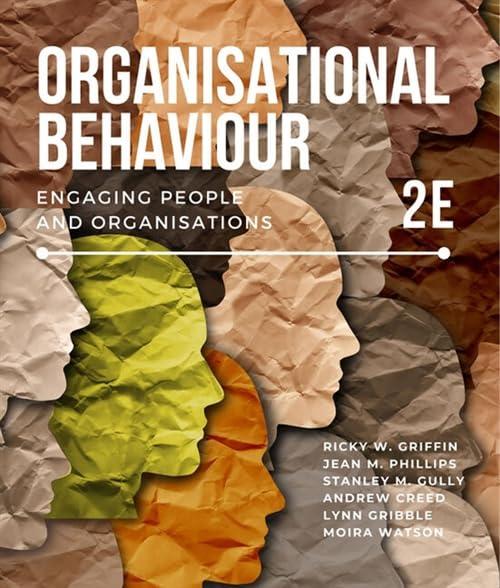When we traditionally think about leadership, we may envision someone who is leader-first: focused on power, money
Question:
When we traditionally think about leadership, we may envision someone who is ‘leader-first’: focused on power, money and material possessions, either for themselves, for their company or both. Employees are not prioritised, and are seen as expendable and as tools for achieving the goals of the leader-first leader. All of the power is concentrated by one person at the top. At the other end of the leadership spectrum are ‘servant-first’ leaders. Rather than focusing on the firm’s bottom line or another agenda, servantleadership focuses on serving others, sacrificing their own agenda in the process. The goal here is to put ‘the needs of others first’ and help ‘people to develop and perform as highly as possible’.64 Due to the increasing number of casual, contracted, temporary and gig workers in the workplace, it is becoming harder than ever to engage with employees. However, with a servant-leader at the helm, organisations are more likely to experience positive outcomes, including individuallevel outcomes such as commitment, job satisfaction, engagement and creativity; group-level outcomes such as team performance innovation; and organisational-level outcomes such as overall firm performance.
Traditional leaders have struggled over time with regard to balancing the financial demands of their investors and shareholders with the social responsibility demands of their remaining stakeholders, including employees, customers and community members. While the financial demands have stayed relatively consistent over time (e.g. expectations around generating a profit and a return on investment), the social responsibility demands are ever changing and expanding, making it difficult for the leader to focus on the obligations the firm has to its other stakeholders. This is because the fulfilment of the financial demands has always been seen as the focus of the traditional leader. This in turn is mutually beneficial to this kind of leader: satisfying shareholders can result in increased power and financial rewards. This mentality around corporate social responsibility shifts when a servant-leader is in control. Under servant-leadership, an organisation is able to ‘develop social responsibility strategies without sacrificing their financial goals’. The personal values of these types of leaders help drive the social responsibility strategies of an organisation. As their aim is to use their power to serve their followers, including employees and customers, servant-leaders are able to better respond to the increasing expectations demanded of them by the firm’s stakeholders. Whereas a traditional leader may only pay lip service to corporate social responsibility, a servant-leader understands the advantages of investing in a corporate social responsibility strategy. While the main focus of such a strategy is on the benefits to the servant leader’s followers, a well-structured corporate social responsibility strategy is also seen as a form of competitive advantage for organisations, as well as both attracting and retaining talented employees, and resulting in increased organisational trust, loyalty and brand reputation; increased sales; lower operational costs; and better financial performance. Servant-leadership is seen as ‘critical to success as the business world continues to change rapidly’.65 Rather than promoting a traditional power-hungry leader who dominates their followers and expects them to blindly follow orders, effective organisational change can be accomplished instead by using servant-leaders who listen and empower their employees.
Questions Mainstream
1. What are the main differences between traditional leaders and servant-leaders?
2. What are some demands that an employee, customer, community member, and investor may have of an organisation?
Critical
1. Do you see yourself as more of a traditional leader, a servant-leader, or somewhere in the middle? Explain your reasoning, outlining your leadership traits.
2. How might stakeholders’ corporate social responsibility demands of an organisation change over the next decade? Which external trends do you think will drive these changes? Think from the perspective of employees, customers, community members, and investors.
Step by Step Answer:

Organisational Behaviour Engaging People And Organisations
ISBN: 272389
2nd Edition
Authors: Ricky W. Griffin, Jean M. Phillips, Stanley M. Gully, Andrew Creed, Lynn Gribble, Moira Watson





